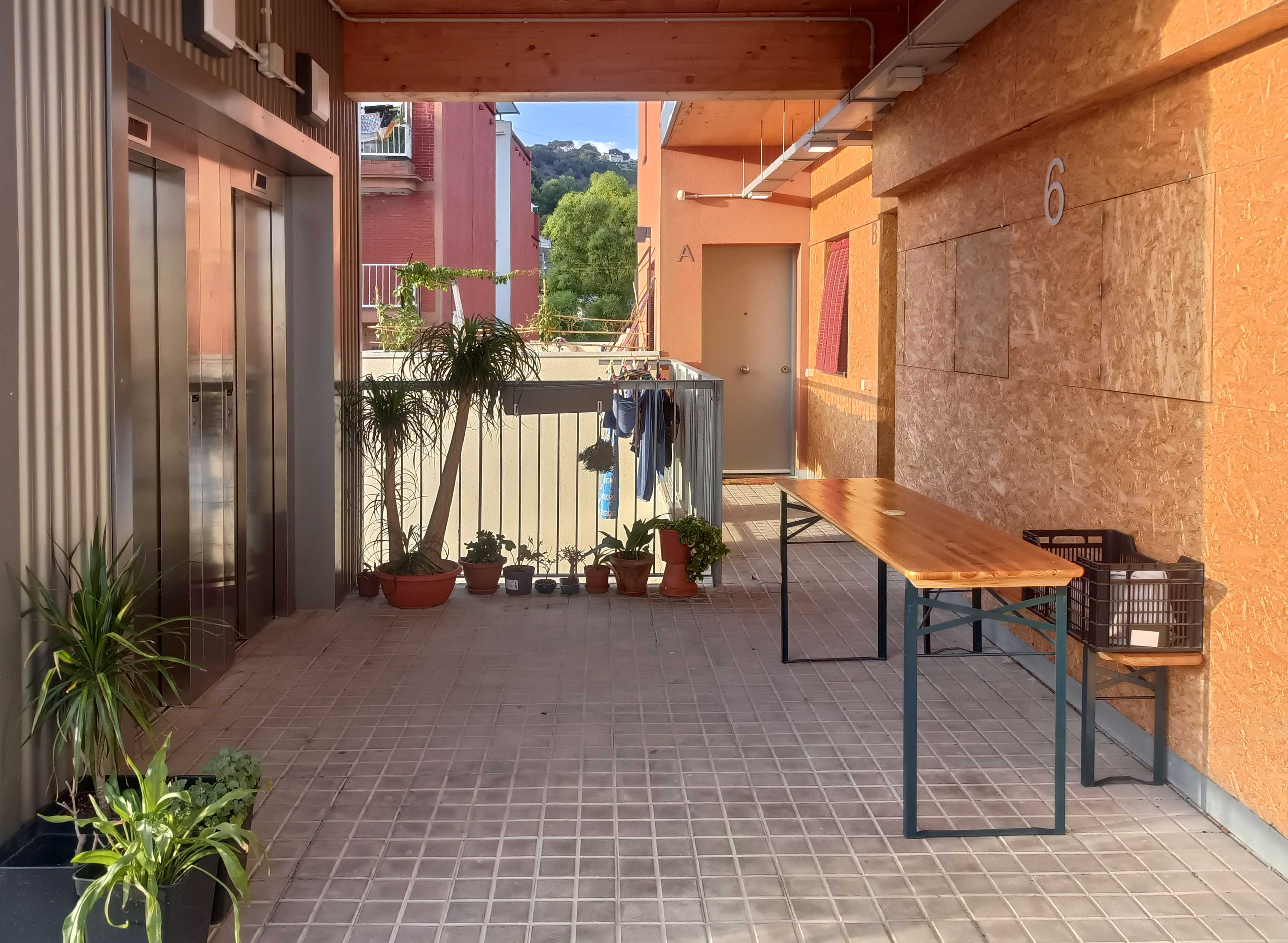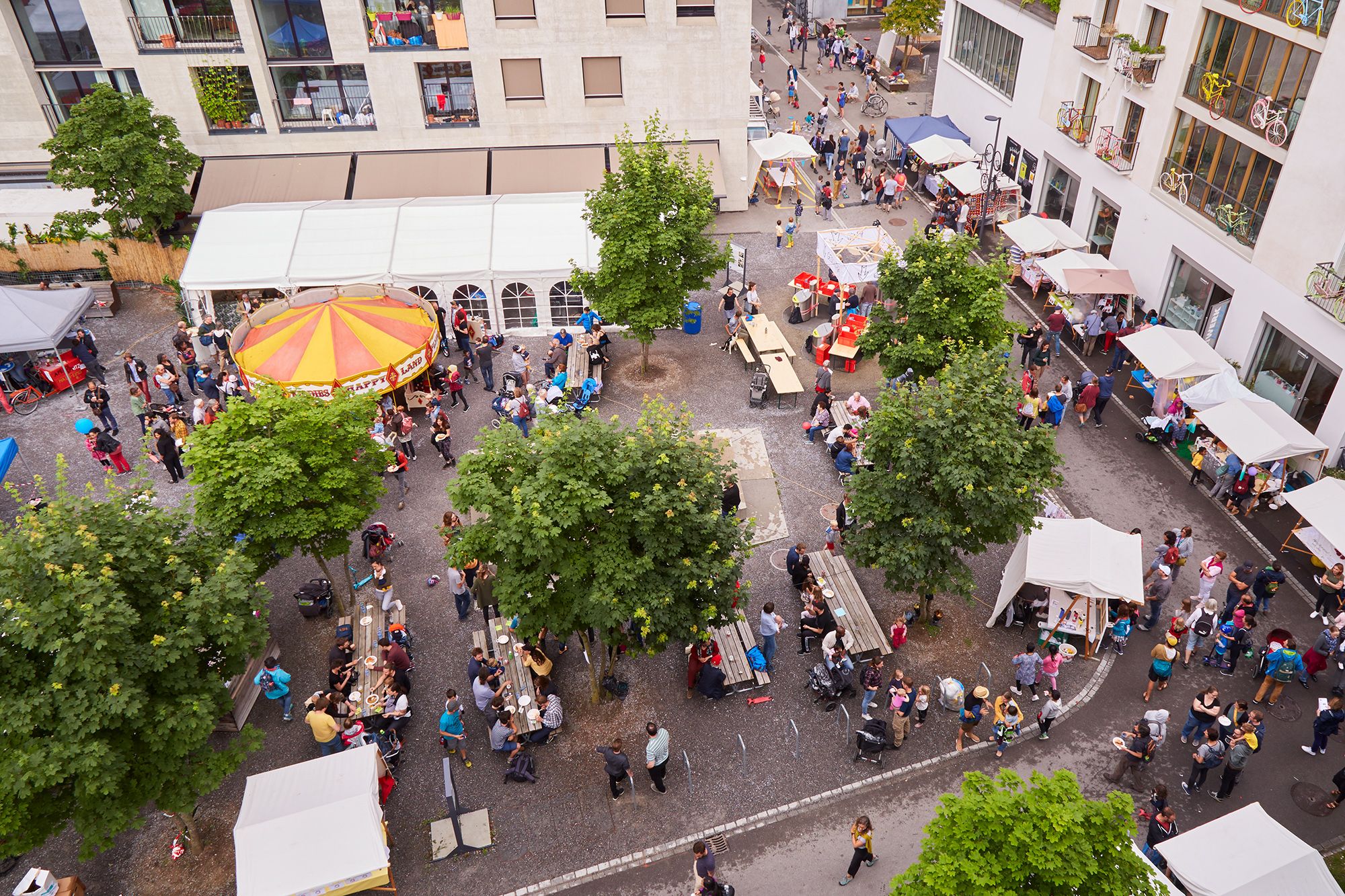Mehr als wohnen – More than housing
Created on 05-10-2023 | Updated on 28-11-2023
Mehr als Wohnen (More than housing) is a housing cooperative (Baugenossenschaft) located in the Hunziker Areal, a former industrial site in the city of Zurich, Switzerland. It is an example of non-profit development, giving rise to a mixed-use neighbourhood with district services, public spaces, and commercial establishments. Initiated in 2007 through a collaboration of 35 housing cooperatives, the project now enjoys support from 60 out of the 120 cooperatives in Zurich. This project set up a new standard for cooperative housing at a neighbourhood scale and stands as potential model for other cities. Comprising 13 residential buildings and 370 housing units, Mehr als Wohnen currently accommodates 1,300 residents. There are 7,000 m2 of ground floor space hosting cafes, restaurants, kindergartens, studios and working spaces. The land is leasehold from the city council for 100 years in exchange for an annual fee. An apartment at the cooperative is on average 20% less expensive than a for-profit apartment in Zurich. The project was developed after an architectural competition, and its financing scheme included a diverse array of sources.
Initiating entity
Mehr als wohnen cooperative, city of Zurich
Objectives
mixed-use neighborhood, community-led housing, affordable housing, communal living
Educational/participatory methods
dialogical process with residents and stakeholders
Context
former industrial site
Place
Zurich, Switzerland
Period
2007-now
Duration
2008-2015
Stakeholders
city of Zurich, cooperative Mehr als wohnen
Object of study
Neihbourhood
Description
The context
In Switzerland, housing cooperatives are private organisations, co-owned and self-managed. The city of Zurich has a rich history of housing cooperatives and non-profit housing associations dating back to the early 20th century, constituting 25% of the city’s housing stock. As was the case in other central European cities, housing cooperatives in Zurich emerged in response to a housing shortage and the unavailability of affordable prices. The model for establishing a housing cooperative is straightforward: individuals come together to form a cooperative, becoming shareholders. The cooperative builds housing and rents it to its members at cost prices. Since no profits are generated, and the land value is not increased for resale, the gap between cooperative rents and open market rents widens significantly over time. Historically, members of housing cooperatives were often affiliated based on profession or religion, such as public officers, for example.
The foundation of this housing cooperative model was laid in 1907 when a law was enacted, assigning responsibility to the municipality for providing ‘affordable and adequate housing’ (Hugentobler et al., 2016). The first housing cooperatives were established in 1910, and the Allgemeine Baugenossenschaft Zürich, ABZ, currently the largest cooperative in Switzerland, was founded in 1916. In the 1970s, cooperative housing faced a decline due to poor maintenance. However, a revival occurred in the 1980s when a new cooperative movement emerged. The new cooperatives aimed to break away from the rigidity, institutionalisation, and outdated principles of traditional housing cooperatives. The discourse of this movement emphasized the need for more sustainable living environments, affordable and non-speculative housing, and social integration. In 2011, a city-scale referendum took place, resulting in the population voting in favour of a law aiming to increase the proportion of non-profit housing to 33% of all housing (not just newly built homes) in the city by 2050. This legislation mandates the city of Zurich to establish a framework and instruments to support non-profit housing.
Process
In 2008, the Public Works Department of the city of Zurich and the cooperative Mehr als Wohnen launched an international competition for ideas. This initiative was part of the festivities marking 100 years since the inception of cooperative housing in Zurich (“Mehr als wohnen - 100 Jahre gemeinnütziger Wohnungsbau”). The competition sought innovative ideas about the future of non-profit housing. Out of 100 submissions, 26 teams of architects were selected and were invited to submit an urban development concept for the Hunziker Areal, including designs for residential buildings. A young team won the master plan competition, aiming to integrate diverse architectural proposals into a cohesive urban development concept. A subsequent dialogue phase ensued, during which architects and project operators collaborated to integrate various concepts into the master plan. Future residents and the broader public participated in 3 to 4 events annually, engaging in discussions about the neighbourhood’s future. The dialogic process continued until construction started in 2012.
Land
The four-hectare plot of disused industrial land at the Hunziker Areal in the Leutschenbach district was made available for building by the city administration. The site formerly housed a concrete industry until the 1980s when the company closed, and the city of Zurich acquired the land. Due to a law approved by a referendum in 2011, the city of Zurich is obligated to prioritize non-profit housing over selling land to the highest bidder. In 2007, the city council signed an agreement with the cooperative for a lease of 100 years, with the possibility of renewal. As part of the agreement, the cooperative must adhere to various conditions, including calculating rents based on investment costs, subsidizing 20% of the housing units, providing 1% of the ground floor for neighbourhood services at no cost to the city, allocating 0,5% of construction costs to local art projects, meeting high energy standards in construction, and launching an architectural competition for the new housing buildings. The cooperative pays an annual fee for the use of the plot, which is adjusted every five years, according to the cost-of-living index and interest rates. This fee also considers the space provided by the cooperative and the subsidies offered to low-income residents.
Funding
Following the agreement with the city council for the land, cooperative members embarked on securing funding. The members of the cooperative had to bring the 5,4% of the initial capital, with the remaining other 0.6% covered by the municipality. The founding cooperatives of Mehr als Wohnen leveraging their existing resources and expertise, contributed half of this amount. The other half was covered by the future residents, amounting to CHF 250/m2 as their member equity. For low-income households or elderly people, the city’s social services could cover this amount.
The remaining funding was obtained from three levels of administration: city, canton and federal. At the federal level, the Federation of Swiss Housing Cooperatives provided a CHF 11 million loan through its revolving fund, offering a twenty-year term with a 1% interest rate. Additionally, at the federal level, CHF 35 million was secured through a bond loan with fixed interest rates for the first twenty years, facilitated by the Bond Issuing Cooperative for Limited Profit Housing (Emissionszentrale für gemeinnütziger Wohnbauträger/ Centrale d’émission pour la construction de logements – EGW/CC) and public subsidies. EGW functions as a financing instrument for housing projects of public interest, guaranteeing loans through the Swiss Confederation (Federal Bureau of Housing) to provide security for investors. Nonprofits benefit from significantly more advantages compared to comparable fixed mortgages with the same terms. At the cantonal level of Zurich, the project secured a CHF 8 million loan, and at the municipal level, another of CHF 8 million, both with fixed interest rates. However, instead of paying the interest to the city and canton of Zurich, the cooperative uses this amount to subsidize 20% of housing units (80 of the 370 apartments). To complete its financial planning, Mehr als Wohnen also secured a CHF 8 million loan from the city of Zurich’s pension fund, with a fixed interest rate. With this combination of sources, providing 27% of the total investments, the remaining necessary financing was obtained from a consortium of four banks through traditional mortgage loans.
Inclusion mechanisms
Mehr als Wohnen employs a mechanism commonly used by many Swiss housing cooperatives, that allows its members to transfer their savings to the cooperative instead of keeping them in traditional banks. These “member funds” constitute part of the cooperative’s capital, meaning that the larger the member funds are, the less the cooperative will rely on mortgages in the future. Members who invest in their cooperatives benefit from a higher investment return compared to what they would receive at a conventional bank. The cooperative also maintains an internal solidarity fund, aiding in financing solidarity projects or assisting families facing difficulties in paying their equity. Every household and commercial store contributes a monthly amount, ranging from 10 to 30 CHF, depending on their income. Through this fund, the cooperative can reduce monthly rents for low-income households, cover maintenance or adaptation fees, organise events, and provide financial support to cooperative projects in the neighbourhood or abroad.
Design innovations
The project is planned for a mixed-residential population and a diverse mix of uses. The term “more” in its name signifies the aim of creating a sense of community and belonging, which is reflected in the interior as well as exterior spaces. The concept revolves around reducing private spaces, with an average of 35 m2 per person for tenants, while providing increased communal areas, such as roof terraces, children’s playgrounds, and car-free spaces. In terms of private spaces, Mehr als Wohnen incorporates various housing typologies to accommodate diverse needs, including cluster apartments, satellites, family apartments, large units capable of housing 7 to 12 individuals, studios and spaces that can be adapted to different purposes. The apartments range from 2 to 7.5 rooms[1], offering a broad spectrum for exploring different residential possibilities. These combinations of spaces highlight diverse household compositions and lifestyles, acknowledging the simultaneous desire for privacy and communal living. Most of the apartments have 4-4.5 rooms (37%), followed by 3-3.5 room apartments (26%), and larger apartments with 5.5 rooms or more (22%). Apartments with 1 to 2.5 rooms account for only 15%, which is a smaller percentage compared to the city of Zurich, where this category represents 34%.
Social inclusion
The aim was to create a “lively quarter where people like to live, work and spend their free time” and should be offered to people from “all social strata” (as stated in Mehr als Wohnen’s mission statement). The aim of the project was that the composition of the residents in the project should reflect the distribution of different households from the canton of Zurich as a whole. In order to achieve a mixed population, the cooperative collaborated with various institutions. A total of 10% of the apartments were reserved for the Züriwerk Foundation, supporting people with impairments; the Domicil Foundation, assisting families with immigrant backgrounds in finding housing; the Woko Cooperative, aiding teachers and students; and the ZKJ Foundation, finding homes for children who could not live with their families.
[1] In Switzerland and Germany, the count of rooms per apartment encompasses more than just bedrooms; it includes any kind of room present in the apartment. The term "half room" typically refers to spaces that aren't fully designated as bedrooms, such as a living room that could potentially be converted into one. It's important to note that bathrooms and toilets are not included in this room count.
Alignment with project research areas
The case study of Mehr als wohnen aligns with the research areas of RE-DWELL:
Design, Planning, and Building
Design Innovations: Mehr als Wohnen embraced design innovations through the integration of diverse housing typologies, including cluster apartments, satellites, family apartments, studios, and various room sizes. This highlights a commitment to create versatile living spaces that cater for the diverse needs of different households. The project placed a strong emphasis on adhering to high energy standards, aiming to create sustainable buildings and mitigate their impact on the environment.
Community Participation
The project facilitated a dialogic process that engaged architects, project operators, future residents, and the broader public. By organizing regular events and discussions, the project actively incorporated stakeholders into the process of shaping the neighbourhood’s future. This commitment aligns with the research area of community participation, underlining the significance of involving residents and stakeholders in decision-making processes to foster a sense of ownership and community.
Policy and Financing
The project employed a diverse range of funding sources, including member equity contributions, loans from different levels of administration (city, canton, and federal), bonds, and loans from banks. This showcases innovative financing strategies to support the development of affordable housing. It aligns with the research area of policy and financing, which explores mechanisms to secure funding for sustainable and affordable housing initiatives and examines the impact of housing policies on housing outcomes.
Alignment with SDGs
Mehr als Wohnen aligns with several Sustainable Development Goals (SDGs) outlined by the United Nations, specifically:
SDG 11: Sustainable Cities and Communities: The project strives to achieve this goal by creating a sustainable and inclusive neighbourhood. It advocates for the development of affordable and non-speculative housing, fosters social integration, and encourages community participation. In doing so, it plays a significant role in advancing the overarching aim of creating cities that are inclusive, safe, resilient, and sustainable.
SDG 7: Affordable and Clean Energy: The project places a strong emphasis on maintaining high energy standards in housing construction. By incorporating sustainable design and energy-efficient technologies, it contributes to reducing energy consumption and promoting clean and affordable energy sources.
SDG 9: Industry, Innovation, and Infrastructure: The project showcases an innovative approach to housing development, amalgamating various funding mechanisms and design concepts. It underscores the potential for innovative partnerships among public institutions, cooperatives, and residents to create a sustainable and inclusive infrastructure.
SDG 10: Reduced Inequalities: Mehr als Wohnen strives to establish a diverse and inclusive community by allocating a portion of its housing units to vulnerable groups, including persons with impairments, families with immigrant backgrounds, and children in need. This commitment to social inclusion contributes to reducing inequalities within the neighbourhood, and within the city.
SDG 13: Climate Action: The project's emphasis on sustainable construction, energy efficiency, and reduction of environmental impact aligns with this goal. By promoting sustainable housing practices, it contributes to mitigating climate change and building resilience to its impacts
SDG 17: Partnerships for the Goals: The collaborative ethos of the project, engaging project operators, future residents, and the broader public, underscores a commitment to partnership and collaboration. By fostering partnerships among various stakeholders, the project contributes to the overall SDG framework.
References
CoHabitat Network. (2022). Access to land and finance for community-led housing. https://www.co-habitat.net/en/news/access-to-land--finance-for-community-led-housing-short-case-studies-from-africa-europe-and-latin-america/Financial-mechanisms-in-community-led-housing-may-2022-cohabitat.pdf
Hugentobler, M., Hofer, A., & Simmendinger, P. (Eds.). (2016). More than housing: Cooperative planning - a case study in Zürich. Birkäuser.
Khatibi, M. (2022). Socio-spatial interactions of a cluster-house concept apartment in mehr als wohnen project in Zurich, Switzerland. Frontiers of Architectural Research, 11(2), 191–202. https://doi.org/10.1016/j.foar.2021.10.002
Mehr als wohnen. (2017). A vision becomes reality – 10 years lessons learned. https://www.mehralswohnen.ch/fileadmin/downloads/Publikationen/Broschuere_maw_engl_inhalt_def_181004.pdf
Mehr als wohnen. (n.d.). Cooperative. Retrieved August 30, 2023, from https://www.mehralswohnen.ch/genossenschaft/mehr-als-wohnen/
World Habitat. (2016). More than Housing. https://world-habitat.org/world-habitat-awards/winners-and-finalists/more-than-housing/#award-content
Related vocabulary
Community Empowerment
Community-led housing
Urban Commons
Area: Community participation
Created on 03-06-2022
Read more ->Area: Community participation
Created on 05-10-2023
Read more ->Area: Community participation
Created on 14-10-2022
Read more ->Blogposts

Cooperative housing in Barcelona
Posted on 01-02-2023
Secondments
Read more ->

